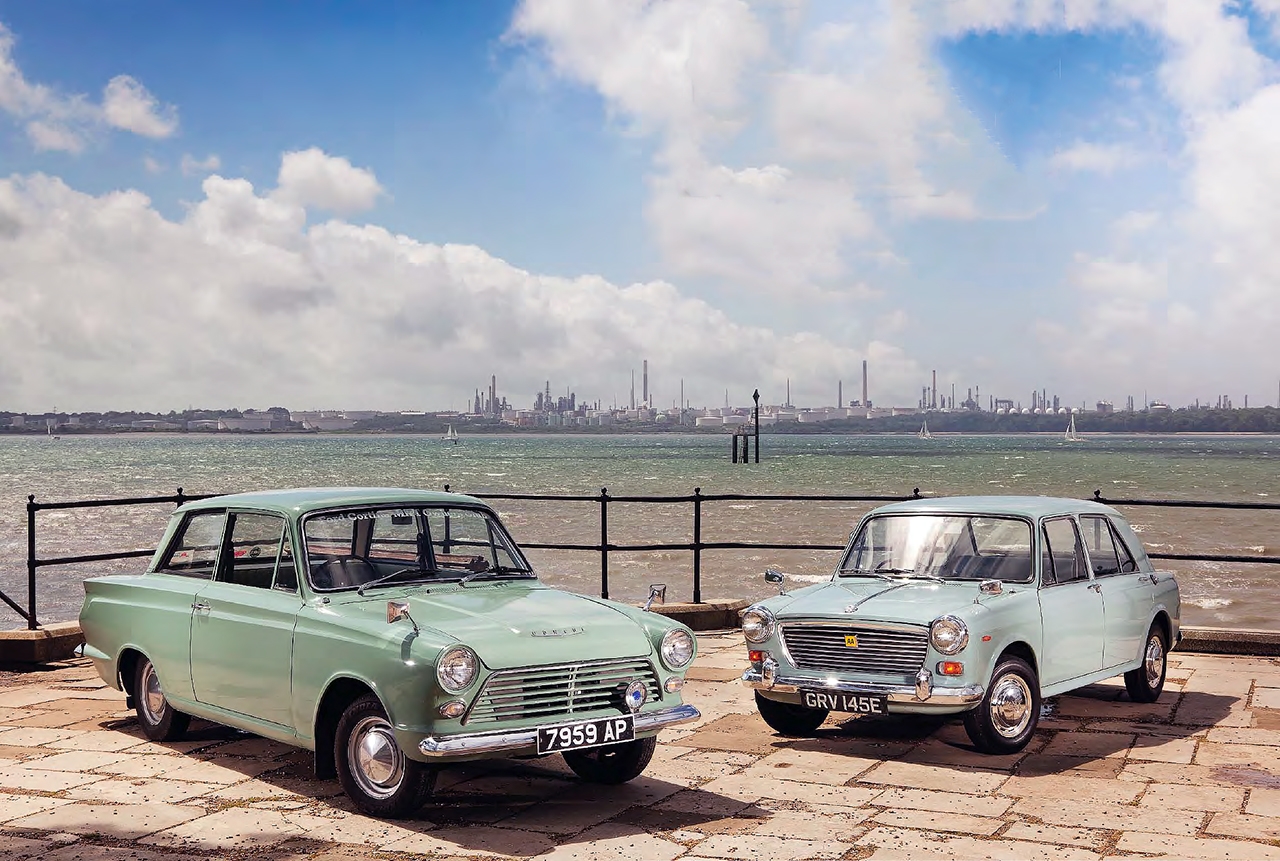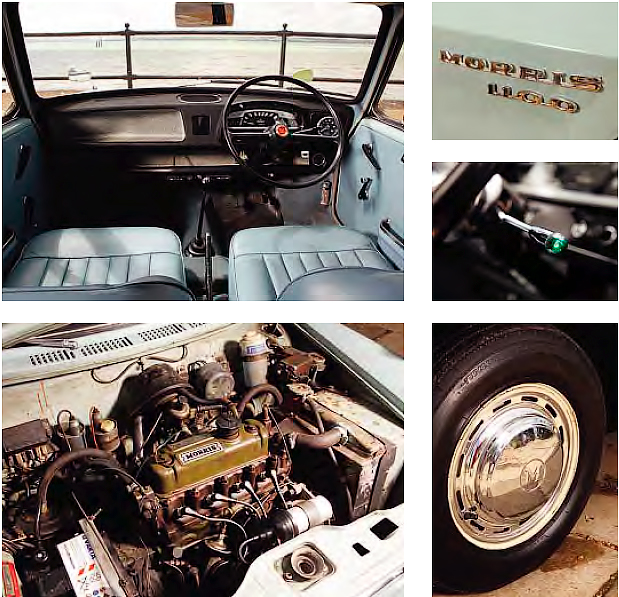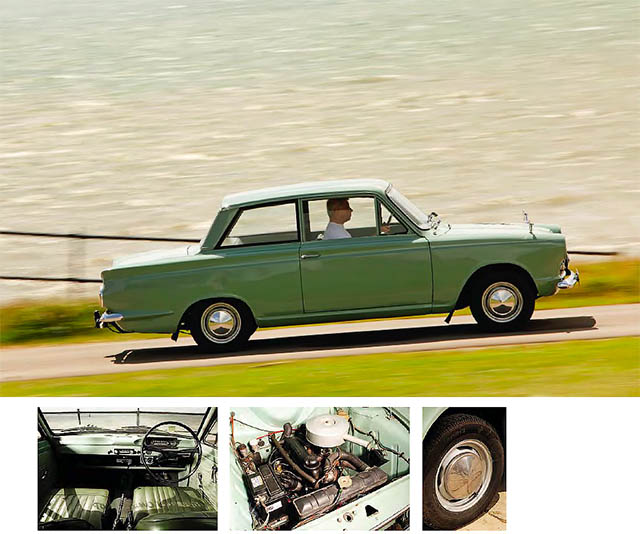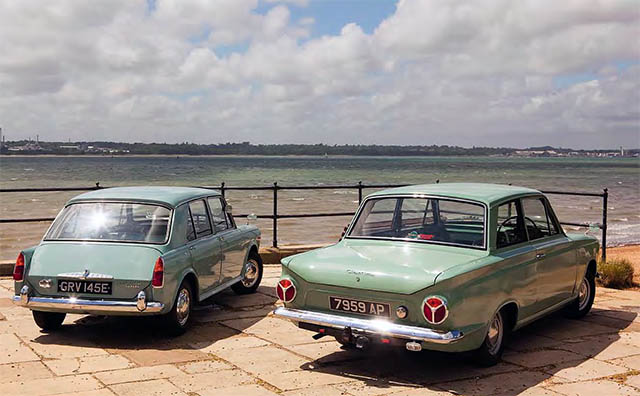
Family favourites. Andrew Roberts recalls a booming Britain in which Ford and BMC courted the mass market with rivals that couldn’t have been more diverse, both launched in ’62 – photography by Tony Baker.
Victoriana and post-WW2 consumerism co-existed uneasily in the Britain into which the Ford Cortina and Morris 1100 were launched. This was a nation in which commuters parked their new cars outside a gas-lit railway station to await a steam-hauled train and where a house without electricity might have been next door to one where ITV promised a brighter future. It was to these families that the Consul Cortina and the 1100 offered the chance of car ownership in radically different forms.

If you are a Briton of a certain age, you may have a major challenge when assessing the Morris: its sheer over-familiarity. The unmistakable sound of that transmission whine and the sight of the BMC flashing indicator stalk will have an instantly Proustian effect. There is also the fact that, not so long ago, virtually every Public Information Film concerning the dangers of frying chips while reversing blindfold in the fog towards a pylon – on mixed radial and crossply tyres – featured an 1100.

Clockwise, from below: Hydrolastic suspension gives the 1100 a supple ride; eager transverse A-series makes it feel quicker than the Ford; flat steering-wheel angle is a touch bus-like; Morris was one of six ADO16 brands; signature flashing indicator stalk; simple wheeltrims were otional
But back in 1962 there was no car in the Morris’ class that could hope to match its blend of innovation, space-efficiency and looks. To own, as your first-ever new car, a front-drive, four-door saloon with a sideways-mounted engine and fluid suspension – sporting lines as sharp as an Italian suit – was the embodiment of Macmillanera affluence. The 1960s was the decade in which the British family motorist would no longer drive the automotive equivalent of suet pudding.
Instead, they would take the wheel of one of the world’s most advanced production cars. The origins of project ADO16 date back to 1958, when BMC decided to make a front-drive saloon to bridge the gap between its mediumsized and its sub-1.1-litre models. The new car was the responsibility of Alec Issigonis, with styling from Pininfarina, but it was Charles Griffin, chief engineer at Morris Motors, who managed to persuade BMC’s directors that the 948cc Minor engine was wholly inadequate for its latest product. One option was a 1.1-litre V4 engine inspired by Lancia, but it would not have worked with a transverse layout so the ADO16 would be powered by an enlarged version of the A-series unit. A further Griffin idea was to equip the car with Hydrolastic suspension – over the initial objections of Issigonis.

Clockwise, from above: there’s a hint of baby ’61 Thunderbird in the clean profile; ‘poverty cap’ trim like Morris; multi-function stalk; boot says Cortina, which model name later became; Radiomobile would have been a later accessory; only 1198cc but at least it was pushrod rather than sidevalve
The Morris 1100 was launched on 15 August 1962, by which point the Mini had finally overcome its early technical problems to become an established part of the motoring landscape. The timing was perfect for a BMC car offering the virtues of the Mini writ large and if, in 2012, the 1100 does not appear especially notable, this is precisely because it was so far ahead of its time. It made the Ford Anglia and the Fiat 1100R look antique, the Morris Minor seem venerable and the VW Beetle appear positively Neolithic.
For a car owner used to rear-drive motoring, the 1100’s driving position came as a mild shock, because it obliged the driver to sit nearly upright over a steering wheel evidently inspired by a Routemaster bus. A second surprise was the sheer space of the interior and the superb visibility offered by the thin-pillared Farina styling. The third departure from the small-car norm was the performance.
When the 1100 made its debut, it did not escape the notice of press-on drivers that it had the same cylinder head and remote-control gearchange as the Mini Cooper plus, despite more objections from Issigonis, disc front brakes.
For a motorist inured to family saloons wallowing all over the nation’s B-roads, ADO16’s ability to corner sans roll plus an engine that positively demanded that to be driven at speed all day was infinitely more important than its habit of pitching over cobbled urban streets.
The Motor predicted that if the 1100 did not sell phenomenally well ‘a lot of people will be eating their hats’, despite that fact that, at £695, the De Luxe version was more expensive than such British (and in-house) rivals as the Austin A40 Farina and the Morris Minor, costing more than even the better-equipped Ford Anglia Super. Indeed, for a mere £629, a motorist could have also enjoyed the entry level model of the latest Ford – the Consul Cortina.
Three years earlier, Dagenham commenced development of a light family car that would weigh less than 1700lb, with the brief of giving buyers optimum performance and economy at the lowest possible cost. The new car would slot between the 105E Anglia and the forthcoming Consul Classic saloon. Sir Patrick Hennessey, chairman of Ford GB, was also determined that ‘Project Cardinal’ would make its debut before a front-drive five-seater from Cologne.
The Cardinal’s budget was limited, so most of the running gear was from Ford GB’s existing line-up, the 1.2-litre engine being an enlarged version of the 105E’s 1-litre Kent unit. Ford was also aware that the upcoming Morris 1100 would be independently sprung and it would not be until as late as May 1961 that a plan to fit the new car with Detroit-sourced IRS was abandoned in the face of a lack of funding.
Knowledge of ADO16 also fuelled Dagenham’s plans to make the Cardinal a ‘big’ family saloon, so the idea of giving it the new model the ‘Breezeaway’ rear screen of the Anglia and the Consul Classic was quickly dropped for the official reason that it made the Cardinal look ‘too small’. In reality, the Consul Classic’s virtues were largely forgotten when potential buyers were confronted with cod-Americana aesthetics as plausible as an off-key Joe Meek vocalist, so the Cardinal had to look ‘conservative cool’.
IT DID NOT ESCAPE THE NOTICE OF PRESS-ON DRIVERS THATTHE 1100 HAD THE SAME HEAD AS A COOPER
One final touch was added the year before the launch, when the original tail-light design was replaced on Detroit’s orders with the now-iconic ‘Ban The Bomb’ units.
As to the new car’s name, the plan was to call it the Consul 225 and it was only months before its debut that it was decided to combine the familiar Consul brand with the name of the host resort for the 1960 Winter Olympics. Thus, in September 1962, Ford launched the Consul Cortina, a 1198cc twodoor saloon in Fleet or De Luxe forms – the latter sporting a chromium-plated radiator grille and a passenger sunvisor among its luxuries.
The Fleet cost only £25 less and its chief market was those sales managers who needed to punish errant commercial travellers with the automotive form of being sent to Siberia. When, in ’63, Ford provided its entire Cortina PR fleet to act as ‘Glamcabs’ in Carry On Cabby it is quite noticeable that the Fleets lurk at the rear of the shot, forever the motoring equivalent of the odd relative only wheeled out at weddings. In the metal, the Fleet is so unabashedly spartan that it only just falls short of having the words ‘National Assistance’ emblazoned on the bootlid. Yet, for all of its rubber floormats and solitary sunvisor, it retains a formidable charm, allowing the opportunity to experience how fundamentally sound the Cortina concept was from the outset.

Subtle Pininfarina lines contrast sharply with American feel of Ford
Any Mk1 conveys a modest air of conspicuous consumption and, as you look at the featured ’63 example, you realise that Roy Brown deserves far more credit for so successfully combining transatlantic design ideas on a European scale.
American influence on everyday British life was a vexed issue in the media in the early ’60s, but the Cortina achieves the difficult balance of slickness without vulgarity – from its sculpted tailfins to those signature rear clusters.
Dagenham also ended 30 years of sidevalve tradition when the 100E Popular ceased production shortly before the first Cortinas arrived in the showrooms. For a motorist looking to trade in their Pop at the friendly local Ford dealer, even the Fleet offered a whole new world. If a 100E is indelibly associated with peering through the porthole-like windows, the flicker of the headlamps battling against a landscape ridden by smog and Woodbine smoke, the Consul Cortina’s airy cabin was little short of a revelation. Admittedly, the Ford’s dynamo meant that the headlamps may still have flickered if you also wanted to use the heater (£17 19s extra), but at least the wipers were electric and there really was space for five plus their luggage.
Compared to the Morris, a Mk1 Cortina does look vast – Ford advertised it as ‘The Small Car With Big Ideas’ – but, despite its size, it weighs just over 1700lb. Dagenham’s use of aircraft stressing techniques meant that the Cortina was light by the standards of the day and even the 1198cc models lack the sluggishness found in the Consul Classic. There’s space for the driver to stretch his legs and the Cortina’s road manners are so entertaining, plus the all-synchro fourspeed ’box – with a floor- or column-mounted lever – is so enjoyable to use, it is no surprise that sales reps of 1962 soon craved a bigger engine.
BOTH CARS SHOWED THAT A LOW PURCHASE PRICE DID NOT EQUATE WITH SACRIFICING ENJOYMENT
Ford had planned a 1.5-litre option from the outset, highlighting a fundamental fault with the ADO16 – its lack of true development. ‘Our’ Morris was made in ’67, a year after the Cortina underwent a major facelift to become the Mk2 and the first time that the ADO16 received the option of a larger powerplant. It could be argued that Pininfarina’s coachwork did not need updating, being far less affected by the vagaries of fashion than the Consul Cortina’s body, and the ADO16’s sales figures – a million cars in five years and consistently Britain’s most popular car – back this up, but BMC basically substituted technical advancement with badge-engineering.
By 1965, UK sales of the ADO16 amounted to 14% of the sector in which it was marketed under six brands to satisfy their warring dealer franchises. After the introduction of the 1.3-litre engine two years later, there was barely any development of the range until its eventual replacement in 1974 by the Austin Allegro, by which point the market was led by the Citroën GS, the Fiat 128 and the Alfasud. Furthermore, the Cortina was but one of a number of highly profitable cars made by Ford GB – whereas the funds derived from the ADO16 increasingly had to shore up most of BMC’s saloon line-up. In contrast, the Mk1 Ford Cortina was so well priced that it could fund its crisply styled successor a mere four years after launch.
The advent of the Cortina and the 1100 mark the beginning of ‘The ’60s’ in the UK as much as David Frost nasally intoning “That was the week that was”, a new branch of Fine Fare taking over the local grocer’s shop and Julie Christie’s entrance in Billy Liar. Both cars showed that a low purchase price did not necessarily have to equate with sacrificing enjoyment, with diverse approaches to offering a new standard of motoring to drivers on a limited budget.
The Ford method was to combine tried and tested mechanicals in a lightweight body at a price to suit commercial and private buyers alike. After a mere two years in production, the Consul prefix was dropped and ‘Cortina’ became a synonym in the UK for a medium-sized car – an accolade that was built on the impact of the original Mk1, a mass-produced saloon that delivered far more than even the brochures promised.
Yet the legacy of ADO16 is far more poignant. Virtually every modern front-wheel-drive, twobox car follows its template, although nearly all of them are imported. The 1100 is more than one of the greatest machines to wear a Morris badge, it is one of Britain’s finest cars – and one of the saddest examples of a wasted opportunity in the history of the UK’s motor industry.
| Car | Morris 1100 De Luxe | Ford Consul Cortina 1200 |
| Sold/number built |
1962-1971/801,966 |
1962-1966/1,013,391 |
| Construction | steel | steel |
| Engine | all-iron, ohv 1098cc ‘four’, SU carb | all-iron, ohv 1198cc ‘four’, Solex carb |
| Max power | 48bhp @ 5100rpm | 49bhp @ 4800rpm |
| Max torque | 60lb ft @ 2500 rpm | 67lb ft @ 2700rpm |
| Transmission | four-speed manual | four-speed manual |
| Drive | driving rear wheels | driving rear wheels |
| Suspension: | ||
| front |
independent, at front by double wishbones |
independent, by MacPherson struts, anti-roll bar |
| rear |
wishbones rear trailing arms; Hydrolastic displacers, anti-roll bar f/r |
live axle, semi-elliptic leaf springs, telescopics |
| Steering | rack and pinion | recirculating ball |
| Brakes | discs front, drums rear | drums all round |
| Wheels | – | – |
| Length | 12ft 23/4in (3727mm) |
14ft (4267mm) |
| Width |
5ft 1/2in (1537mm) |
5ft 21/2in (1585mm) |
| Height |
4ft 5in (1346mm) |
4ft 81/2in (1334mm) |
| Wheelbase | 7ft 91/2in (2375mm) | 8ft 2in (2489mm) |
| Weight | 1834lb (832kg) | 1715lb (778kg) |
| 0-60mph | 20 secs | 22 secs |
| Top speed | 78mph | 75mph |
| Mpg | 35 | 30 |
| Price new | £695 7s 9d | £639 |
| Price now | £4000 | £5000 |
Thanks to The 1100 Club: the1100club.com; Mk1 Cortina OC: mk1cortina.com; Royal Victoria Country Park: hants.gov.uk/rvcp
The owners
Brian Raymond (on right) has been a key figure in the Mk1 Ford Cortina world for many years, although he modestly denies it. The 1963 Fleet is owned by his eldest son, Graham, who bought it in 1988 when he was aged only 16. It remains a favourite car of Raymond junior, but his work commitments prevent him from driving the Cortina as much as he would like. “So Graham very kindly lets his old man have the use of it now and again!” smiles Raymond.
Peter Close first craved an ADO16 when he was a teenaged apprentice back in 1975 and has owned the featured immaculate 1967 De Luxe since 2002. The period accessories on his car – from the wheeltrims to the “patent BMC booster cushion” – only add to its appeal, he says. Close finds his Morris to be: “Enjoyable in so many ways, but especially for its nostalgia value – everyone’s father, or uncle or grandfather, seems to have owned one.”





